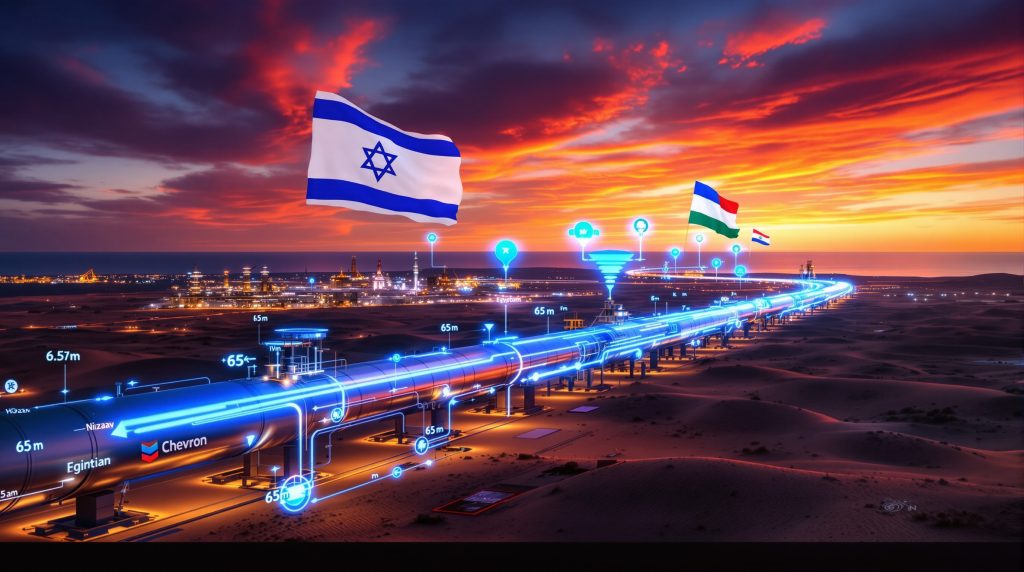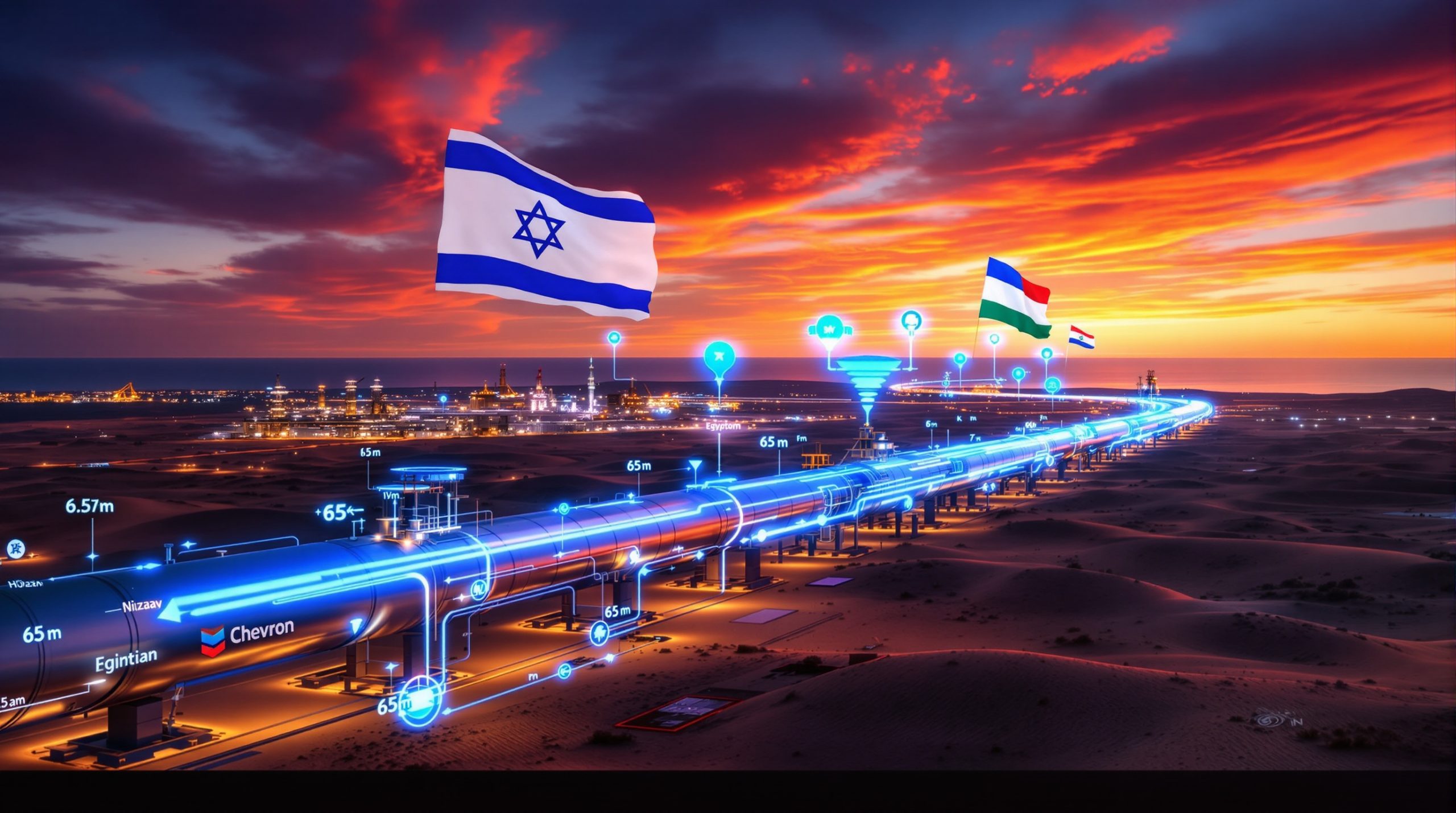The Nitzana Pipeline: Revolutionizing Israel-Egypt Gas Exports
The Nitzana Pipeline represents a transformative development in Eastern Mediterranean energy infrastructure, designed to transport natural gas from Israel's offshore reserves to Egypt. This strategic energy corridor will connect Israel's southern region to the Egyptian border, enhancing regional energy cooperation while addressing Egypt's growing domestic gas demands.
The pipeline infrastructure encompasses a comprehensive development plan including a 65-kilometer route from Ramat Hovav in southern Israel to the Nitzana border crossing, a new compressor station to maintain optimal gas pressure, connection infrastructure to integrate with existing Egyptian networks, and capacity to transport approximately 600 million cubic feet of natural gas daily.
How the Nitzana Pipeline Will Transform Regional Energy Dynamics
Expanding Israel's Export Capabilities
The completion of the Nitzana Pipeline will dramatically increase Israel's gas export capabilities to Egypt, pushing total capacity beyond 2.2 billion cubic feet per day. This expansion represents a fundamental shift in regional energy relationships, positioning Israel as a major energy supplier to its neighbor.
The pipeline complements existing export infrastructure, creating a more robust and resilient energy corridor between the two nations. This enhanced capacity allows Israel to monetize its substantial offshore gas discoveries more effectively while strengthening diplomatic and economic ties with Egypt.
Addressing Egypt's Energy Security Challenges
Egypt faces significant domestic energy challenges, including fluctuating production levels, growing internal demand for natural gas, costly liquefied natural gas (LNG) imports to meet supply gaps, and the need for reliable gas supplies for its LNG export facilities.
The Nitzana Pipeline offers a solution to these challenges by providing a steady, reliable source of natural gas from Israel's substantial reserves. This arrangement helps Egypt manage its energy security outlook more effectively, reducing dependence on expensive LNG imports while maintaining export capabilities.
Enhancing Regional Energy Integration
The pipeline project signifies a deepening of energy cooperation in the Eastern Mediterranean region. By physically connecting the energy systems of Israel and Egypt, it creates opportunities for broader regional integration and collaboration.
Energy analysts note that this infrastructure project could serve as a model for future cross-border energy initiatives in the region, potentially including other countries like Cyprus and Jordan in an expanded regional energy network.
Development Timeline and Construction Schedule
The Nitzana Pipeline project follows a structured timeline with construction expected to begin in Q4 2025. The development phase will run through 2026-2027, focusing on pipeline laying and compressor station construction. Following a testing period in early 2028, the project is projected to be completed by late 2028.
This three-year construction timeline reflects the project's complexity and scale. All phases remain subject to regulatory approvals from both Israeli and Egyptian authorities, with environmental assessments and permitting processes running concurrently with early development work.
Energy infrastructure experts highlight that the timeline allows for proper engineering assessments and environmental impact studies to be completed. The phased approach also provides flexibility to address any technical or regulatory challenges that might arise during construction.
| Project Phase | Expected Timeline | Key Activities |
|---|---|---|
| Construction Start | Q4 2025 | Site preparation, materials procurement |
| Development Phase | 2026-2027 | Pipeline laying, compressor station construction |
| Testing Period | Early 2028 | System integrity verification, operational testing |
| Projected Completion | Late 2028 | Commissioning and commercial operations |
Key Stakeholders in the Nitzana Pipeline
Project Developers and Operators
Chevron leads the pipeline development initiative in partnership with Israeli authorities. As the operator of the Leviathan gas field, Chevron brings significant technical expertise and project management capabilities to this cross-border infrastructure project.
The company will oversee construction of the critical compressor station at Ramat Hovav, which will ensure gas flows efficiently through the pipeline system to Egyptian destinations. Chevron's involvement underscores the project's global significance and commercial viability.
Gas Supply Partners
The Nitzana Pipeline will primarily transport gas from the Leviathan field, whose partnership structure includes Chevron as the operator, NewMed Energy, and Ratio Energies as key stakeholders.
Additionally, Energean plans to utilize the pipeline infrastructure once operational to transport up to 2 billion cubic meters annually from its Katlan field offshore Israel, expected to begin production around 2027.
Government and Regulatory Bodies
Both Israeli and Egyptian government agencies play crucial roles in overseeing the project's development. These include:
- Israeli Ministry of Energy and Infrastructure
- Egyptian Ministry of Petroleum and Mineral Resources
- Environmental protection authorities in both countries
- Security and border management agencies
Their coordination is essential for navigating the complex regulatory landscape and ensuring the project meets all necessary requirements for cross-border energy infrastructure.
The Strategic Importance of the Leviathan Gas Field
The Leviathan gas field stands as the cornerstone of Israel's emergence as a regional energy power, with approximately 600 billion cubic meters of natural gas reserves. This massive offshore discovery has transformed Israel from an energy-dependent nation to an energy exporter in just over a decade.
Key characteristics that make Leviathan central to regional energy security include:
- World-class reserve size comparable to major global gas fields
- Strategic location in the Eastern Mediterranean
- High-quality gas composition requiring minimal processing
- Proximity to growing regional markets
- Scalable production capacity to meet evolving demand
The field's development has attracted significant international investment and expertise, with Chevron's involvement highlighting its global importance. As production continues to ramp up, Leviathan will remain the primary source for Israeli gas exports through the Nitzana Pipeline and other export routes.
Technical Specifications and Development History
Discovered in 2010, the Leviathan field lies approximately 130 kilometers west of Haifa in waters 1,500 meters deep. Production began in December 2019 after significant technical challenges were overcome. The field utilizes subsea infrastructure connected to a floating production platform that processes the gas before sending it to shore.
Industry experts note that Leviathan's gas composition—primarily methane with low levels of impurities—makes it ideal for export, requiring less treatment than many competing sources. This quality advantage translates to lower processing costs and greater market flexibility.
Supporting Broader Regional Agreements
The $35 Billion Export Framework
The Nitzana Pipeline forms a crucial component of a broader $35 billion export agreement between the Leviathan partners and Egypt. This comprehensive framework includes:
- Long-term gas supply commitments for Egyptian domestic consumption
- Provisions for gas delivery to Egypt's LNG liquefaction facilities at Idku and Damietta
- Flexibility for re-export of Israeli gas as LNG to global energy markets
- Structured pricing mechanisms aligned with regional market conditions
This agreement represents one of the largest energy deals in the Eastern Mediterranean's history, underscoring the strategic importance of Israeli gas to Egypt's energy strategy.
Diplomatic and Security Implications
Beyond its commercial significance, the pipeline project reinforces diplomatic ties between Israel and Egypt, building on the peace treaty that has endured since 1979. Energy cooperation provides a concrete foundation for continued regional stability by:
- Creating mutual economic dependencies
- Establishing institutional frameworks for ongoing cooperation
- Providing incentives for maintaining peaceful relations
- Developing shared infrastructure requiring joint protection
The pipeline also reflects broader regional energy cooperation initiatives, potentially serving as a model for future cross-border energy projects in the Eastern Mediterranean.
East Mediterranean Gas Forum Connection
The Nitzana Pipeline aligns with the objectives of the East Mediterranean Gas Forum (EMGF), established in 2019 as a platform for regional cooperation in natural gas development. The forum, which includes Egypt, Israel, Greece, Cyprus, Italy, Jordan, and Palestine, aims to create a regional gas market and optimize resource development.
Energy policy analysts suggest that the pipeline's development strengthens the EMGF's role as a facilitator of regional energy integration and could encourage similar projects between other member states.
Potential Challenges to Pipeline Development
Regulatory and Permitting Hurdles
Both Israeli and Egyptian regulatory frameworks must align to facilitate smooth project development. Potential issues include:
- Environmental impact assessment requirements
- Land acquisition and right-of-way permissions
- Security clearances for critical infrastructure
- Export licensing and approval processes
These regulatory processes could potentially extend timelines if not managed effectively by project stakeholders.
Regional Security Considerations
The pipeline's location in a geopolitically sensitive region necessitates robust security planning. Potential concerns include:
- Physical security of above-ground infrastructure
- Cybersecurity for operational technology systems
- Coordination of security responsibilities between nations
- Protection against potential terrorist threats
These security considerations require careful planning and coordination between Israeli and Egyptian authorities to ensure the pipeline's operational integrity.
Market and Economic Factors
Several economic factors could influence the pipeline's long-term viability:
- Global natural gas price fluctuations
- Competition from alternative energy sources
- Changes in Egyptian domestic production
- Development of competing regional gas resources
Project stakeholders must account for these market uncertainties in their planning and commercial arrangements to ensure the pipeline's economic sustainability.
Technical and Construction Challenges
The pipeline route traverses challenging terrain, including desert areas subject to extreme temperature variations. Engineering experts point to several technical considerations:
- Material selection to withstand harsh environmental conditions
- Corrosion prevention in saline soil conditions
- Seismic activity monitoring and mitigation
- Water resource protection during construction and operation
These technical challenges require specialized engineering solutions and careful construction management to ensure the pipeline's long-term reliability and safety.
Economic Benefits for Both Nations
Advantages for Israel
The Nitzana Pipeline offers Israel several significant economic advantages:
- Expanded monetization of offshore gas resources
- Increased export revenue and tax income
- Enhanced energy sector development and job creation
- Strengthened position in regional energy markets
- Attraction of additional foreign investment in energy infrastructure
These benefits support Israel's broader economic strategy of leveraging its natural resources for sustainable economic growth while addressing potential energy exports challenges.
Strategic Advantages for Egypt
For Egypt, the pipeline provides crucial support for its energy strategy:
- Reliable gas supplies for domestic consumption
- Reduced dependence on costly LNG imports
- Maintained operation of LNG export facilities
- Strengthened position as a regional energy hub
- Revenue from transit and processing fees
These advantages help Egypt manage its complex energy balance while maintaining its strategic position in regional and global energy markets.
Economic Impact on Local Communities
Beyond national benefits, the project is expected to create significant economic opportunities for local communities along the pipeline route. These include:
- Direct employment during construction (estimated at 1,500-2,000 jobs)
- Long-term operational and maintenance positions (150-200 permanent jobs)
- Support service development in nearby communities
- Infrastructure improvements in transportation and utilities
- Skills development and technology transfer
Economic development experts note that these local benefits can help address regional economic disparities and provide sustainable growth opportunities in less-developed areas.
Future of Eastern Mediterranean Energy
The Nitzana Pipeline represents more than just physical infrastructure—it signals a fundamental shift in Eastern Mediterranean energy dynamics. Looking ahead, several developments may emerge:
- Increased integration of regional energy markets
- Potential expansion to include other regional producers like Cyprus
- Development of additional export routes to European markets
- Deeper institutional cooperation on energy matters
- Possible formation of a regional energy forum or organization
These developments could transform the Eastern Mediterranean from a region historically dependent on energy imports to an integrated energy production and export hub with global significance.
Renewable Energy Integration
While the Nitzana Pipeline focuses on natural gas, energy analysts point out that it could eventually play a role in the region's transition to renewable energy. Future adaptations might include:
- Blending hydrogen with natural gas for lower carbon intensity
- Using pipeline infrastructure for carbon capture and storage
- Leveraging gas revenues to fund renewable energy development
- Creating integrated energy systems combining gas and renewables
This long-term perspective positions the pipeline as a transition infrastructure that could evolve with changing energy needs and environmental priorities, similar to considerations in the Alaska drilling policy discussions.
Environmental Considerations and Mitigation Strategies
The Nitzana Pipeline project includes comprehensive environmental management plans to address potential impacts on the sensitive desert ecosystems along the route. Key environmental considerations include:
- Minimizing habitat disruption during construction
- Water resource protection measures
- Air quality monitoring and emissions control
- Noise and visual impact reduction
- Restoration of disturbed areas post-construction
Environmental experts note that pipeline transport of natural gas has significantly lower environmental impacts compared to alternative transportation methods such as LNG shipping, which requires energy-intensive liquefaction and regasification processes, according to a recent Reuters report.
FAQ: Chevron and Israel's Nitzana Pipeline Project
How much gas will the pipeline transport daily?
The Nitzana Pipeline is designed to transport approximately 600 million cubic feet of natural gas per day, significantly boosting Israel's export capacity to Egypt.
Will the pipeline affect global LNG markets?
Yes, by supplying gas to Egypt's LNG facilities, the pipeline indirectly supports Egypt's ability to export LNG to global markets, potentially influencing regional LNG pricing and availability.
How does this project compare to other regional gas pipelines?
The Nitzana Pipeline represents one of the most significant cross-border energy infrastructure projects in the Eastern Mediterranean, comparable in strategic importance to the Arab Gas Pipeline, though focused specifically on Israeli gas exports to Egypt.
What environmental considerations are being addressed?
The project will undergo comprehensive environmental impact assessments, with particular attention to sensitive desert ecosystems along the route, water resource protection, and emissions reduction during construction and operation.
How will the pipeline be protected against security threats?
The pipeline will incorporate multiple security layers, including physical barriers, surveillance systems, cyber protection measures, and coordinated security protocols between Israeli and Egyptian authorities.
What role does the pipeline play in regional geopolitics?
Beyond its commercial aspects, the pipeline strengthens political and economic ties between Israel and Egypt, potentially serving as a model for broader regional cooperation and stability in the Eastern Mediterranean. As The Times of Israel reported, this deal represents one of the most significant energy partnerships in the region's history, with far-reaching trade impact insights for both nations.
Wondering Which Companies Will Make the Next Major Mineral Discovery?
Discovery Alert's proprietary Discovery IQ model delivers instant notifications on significant ASX mineral discoveries, empowering investors to identify actionable opportunities before the broader market. Explore how historic discoveries have generated substantial returns by visiting Discovery Alert's dedicated discoveries page and position yourself ahead of the market.




